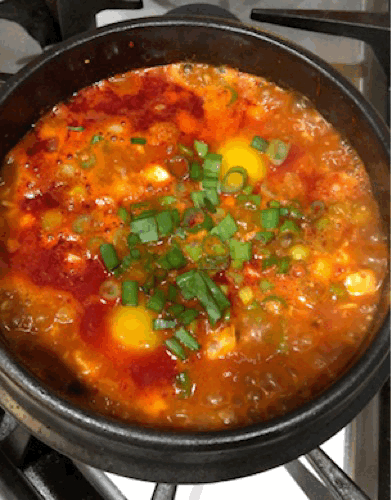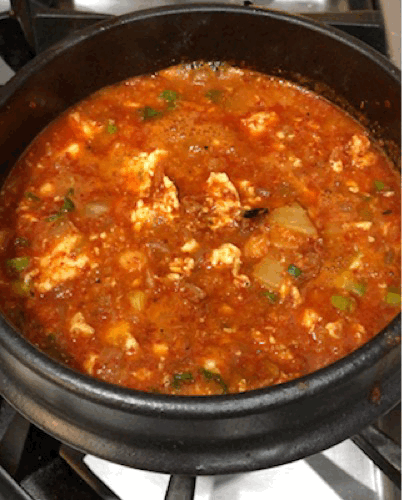Easy Authentic Sundubu Jjigae: Korean Soft Tofu Stew Recipe
When I put kimchi and tofu together in a stew it feels like my new comfort food—similar to how many Americans think of chicken noodle soup—only with more kick. Definitely more kick!
Do babies eat Kimchi? The first time I remember having this Korean side dish is September 1999. I say the first time I remember because even though I was born in Korea I was adopted when I was only a year old and grew up in Iowa. I didn’t even know this well-known Korean dish existed until I had kids myself. But in Korea kimchi is often consumed at every meal, so it does seem possible I may have eaten it at some point before I was sent to the U.S.
My first memory of eating kimchi is at The Gathering in Washington D.C. in 1999. An event that brought the first generation of Korean adoptees together (anyone 18 or older at the time). One of the events was held at the Korean Embassy and as I recall they said the Korean ambassador’s wife made the kimchi that was served. But as you may have already guessed, I was not a fan of the very distinct flavor. Just one more thing that made me feel less Korean.
In my defense I’m also not a fan of sauerkraut—and kimchi is comparable as both are fermented cabbage dishes. Kimchi typically has a kick to it because one of the main ingredients is gochugaru (Korean hot pepper flakes). I found I like sauerkraut when eaten with other food—like Happy Joe’s signature pizza that pairs sauerkraut with Canadian bacon (it’s even better than pineapple). The tartness of sauerkraut is just what the bland Canadian bacon needs to liven it up. I also put it on top of pulled pork sandwiches similar to the southern tradition of topping with coleslaw. Turns out kimchi is also eaten with or added to many different dishes.
As my identity began evolving I knew I had to give kimchi another chance if I was going to truly try to channel my inner-Korean. My second attempt was at Jang Su Jang—an authentic Korean restaurant in the suburb of Duluth, north of Atlanta on my (fake) birthday in July 2020. Kimchi was one of the banchan (side dish) and I had promised myself I would try every single one (I can be a picky eater). It wasn’t as bad as I remembered when I took that bite in 1999 but I also realized I would probably be one of those people who like it better eaten with other foods. It adds both texture and flavor that compliment many other dishes similar to my experience with sauerkraut.
My two favorite ways to consume kimchi are in sundubu jjigae (soft tofu stew) and kimchi jeon (kimchi pancakes). The first time I had sundubu jjigae was at Kyung’s Seafood restaurant in June 2021. I’m also not a fan of tofu. Not because it tastes bad, I just feel like I’m eating a tasteless sponge. But if you add it to dishes that are full of flavor —now that’s a game-changer! The soft tofu stew came bubbling in an earthenware pot and I liked it so much I had it again at another Korean restaurant a few days later. And again in July on my birthday at Sokongdong Tofu House in Atlanta.
I generally decide I want to learn to cook a particular dish when I want it more often than I find myself going out to eat. During the pandemic, this has been especially true. Not only can I have it as often as I want but I can also save a lot of money if I make it at home. Sundubu jjigae has become one of those dishes. One bowl at the tofu house is $13.99 (before tip and tax), but the ingredients for the two serving recipe are less than five dollars.
My first go-to place for an authentic recipe is usually Maangchi’s cookbook. I was excited when I saw I could make sundubu jjigae right in the earthenware pot they serve it in at Korean restaurants. It took me a couple of trips to Hmart to figure out which size to get because the first one was too small for my recipe (size small) —but I kind of wish I had kept it because I’m thinking more times than not I should only make half the recipe, which would be one serving. I’m pretty sure I have the medium size but there are no markings on the bottom of the pot so I’ll check next time I’m at Hmart to confirm. When I make the full recipe, I usually end up eating it all—at one time! It’s easy and quick enough to make so I prefer it freshly made as opposed to reheating. But the earthenware pot serves more than one purpose. Not only is it less messy to only use one dish, but it also keeps the stew nice and warm while you’re eating. It’s literally still bubbling when you put it on the table. And we can’t forget about the presentation because it really does look lovely as well as more authentic served in the Korean earthenware pot. [Update 3/1/22 I decided to only eat half of the stew when I made it yesterday. I left the remaining in the earthenware pot, put the lid on, and stuck it in the frig. Tonight I pulled it out, took the lid off to reheat and it was quite yummy. It was thicker than the first serving I ate when it was fresh, so if you don’t mind that, and you want something quick to eat the next day, then reheating is not such a bad option. I still like fresh best but considering this was zero work, I can’t complain!]
When I get kimchi I like to chop it into bite-size pieces the first time I open the container. That way it’s easier to use each time I want some for stew or pancakes. The less work I have to do when cooking the more likely I am to actually cook. I also prefer to purchase the kimchi that’s been made in-house locally at the store.
As mentioned earlier this stew has a kick to it. But you can control how spicy it is by how much of the red pepper flake mixture you add. If you use what the recipe calls for it will be similar to the “regular or normal” spice level at a Korean restaurant. If spicy isn’t your thing definitely experiment with how much you add the first time or two you make it.
The original recipe calls for two 11 ounce tubes of soft tofu. When I was making it, I misread and thought it said 1/2 a tube but I squeezed in about 3/4 because as I eyeballed it I knew I wanted a bit more. Maybe the third or fourth time when I finally noticed it said 2 - 11 oz tubes I was shocked because it felt to me like I was already using more than what I get in the restaurant version. My recipe reflects what I like to use, but if you feel like it’s lacking then by all means add more. Soft tofu comes in both a tube and a block. I’ve used both. I’ve also used silken and one time I used medium because that’s all that was in the frig. The tube is going to be more broken up just by nature. The block I usually slice into bite-size square chunks.
The original recipe also calls for salt but I leave this out because it seems like there’s enough salt between the kimchi and the chicken stock. If I can cut down on sodium without adversely affecting the flavor I’m all for using less salt. I’ve never tasted my homemade soft tofu stew side-by-side with a restaurant version but my memory seems to think they taste the same.
I hope this recipe (and the gifs of my sundubu jjigae) inspire you to try cooking this Korean dish. From start to finish this recipe takes less than 30 minutes to make if you follow my directions and suggestions. That seems pretty reasonable for a fresh hot authentic Korean stew. Let me know in the comment section how it turned out if you try this recipe—or if you’re already a fan of soft tofu stew!
WHERE TO GET IT ONLINE
This section contains affiliate links. I may receive a commission for purchases made through these links—which helps support this blog—but at no additional cost to you!
Click on the links—I’ve done the homework so you don’t have to!
$19.99 Medium size Korean Stone Bowl with Trivet, Premium Ceramic, Stone Pot Hot Pot for Bibimbap Soup Jjiage.Also available in extra small, small, and large sizes.
Korea Stone Bowl with Lid and Trivet
$39.99 XL Korean Stone Bowl with Trivet & Lid, Premium Ceramic, Stone Pot Hot Pot for Bibimbap Soup Jjiage
Maangchi's Real Korean Cooking: Authentic Dishes for the Home Cook 2015 [HARDCOVER]
$17.99 + FREE SHIPPING with Prime or $25 order HARDCOVER Maangchi's cookbooks should be a staple in the kitchen of anyone who wants to make authentic Korean recipes! My copy of Maangchi's cookbook is full of bookmarks for recipes I've made or want to try!
Maangchi's Real Korean Cooking: Authentic Dishes for the Home Cook 2015 [KINDLE]
$14.99 if you'd rather have the Kindle version.
Maangchi's Big Book of Korean Cooking: From Everyday Meals to Celebration Cuisine 2019 [HARDCOVER]
EDITOR'S PICK $17.55 + FREE SHIPPING with Prime or $25 purchase I have this cookbook too! If you want authentic Korean recipes you can't go wrong with Maangchi! The New York Times Best Cookbooks of Fall 2019, Eater Best Fall Cookbooks 2019, Bon Appetit's "Fall Cookbooks We've Been Waiting All Summer For", Amazon's Pick for Best Fall Cookbooks 2019, Forbes Finds 15 New Cookbooks for Fall 2019
Maangchi's Big Book of Korean Cooking: From Everyday Meals to Celebration Cuisine 2019 [KINDLE]
$19.99 for the Kindle version.
MORE AUTHENTIC KOREAN RECIPES
Click on any title to see recipe






